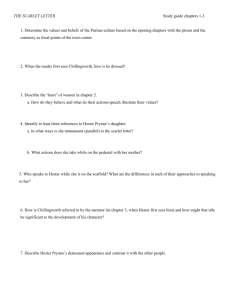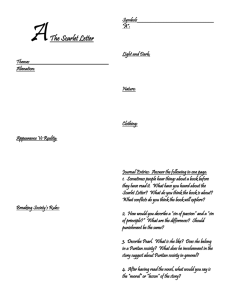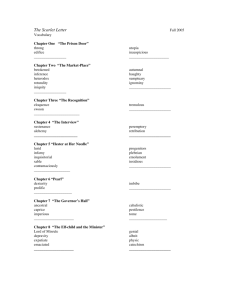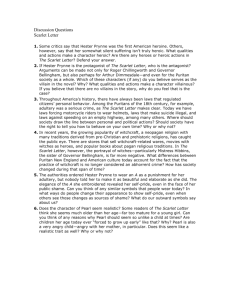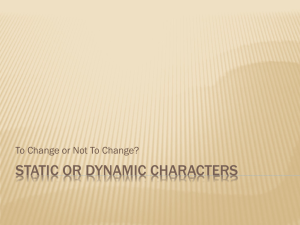The Scarlet Letter Lesson Plan
advertisement
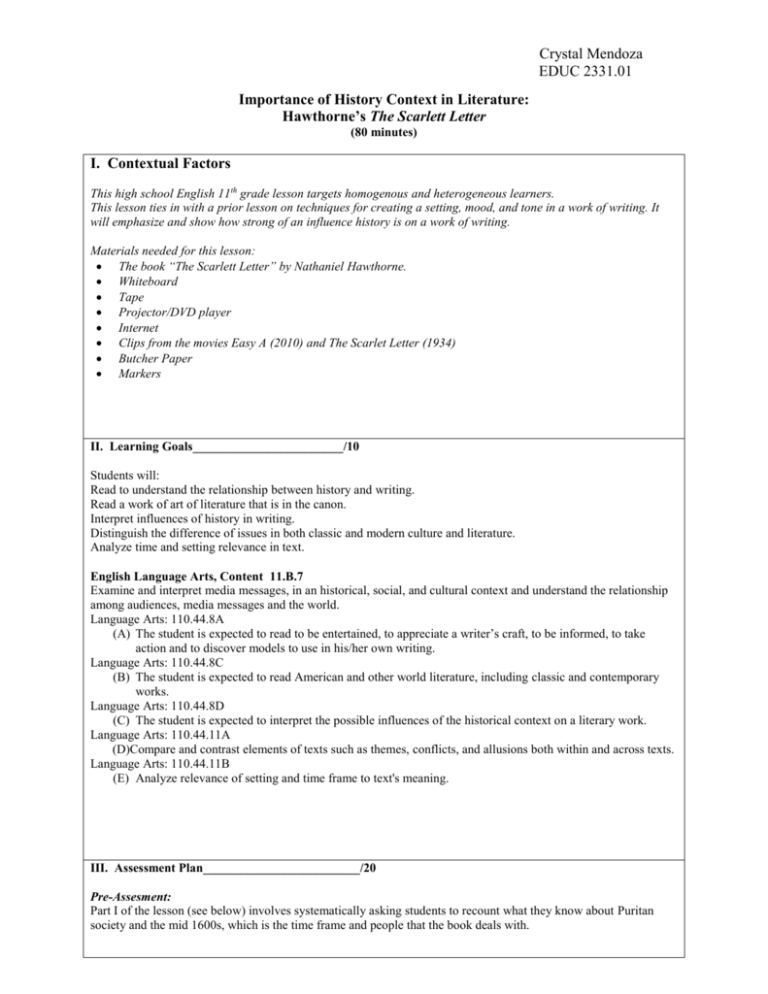
Crystal Mendoza EDUC 2331.01 Importance of History Context in Literature: Hawthorne’s The Scarlett Letter (80 minutes) I. Contextual Factors This high school English 11th grade lesson targets homogenous and heterogeneous learners. This lesson ties in with a prior lesson on techniques for creating a setting, mood, and tone in a work of writing. It will emphasize and show how strong of an influence history is on a work of writing. Materials needed for this lesson: The book “The Scarlett Letter” by Nathaniel Hawthorne. Whiteboard Tape Projector/DVD player Internet Clips from the movies Easy A (2010) and The Scarlet Letter (1934) Butcher Paper Markers II. Learning Goals________________________/10 Students will: Read to understand the relationship between history and writing. Read a work of art of literature that is in the canon. Interpret influences of history in writing. Distinguish the difference of issues in both classic and modern culture and literature. Analyze time and setting relevance in text. English Language Arts, Content 11.B.7 Examine and interpret media messages, in an historical, social, and cultural context and understand the relationship among audiences, media messages and the world. Language Arts: 110.44.8A (A) The student is expected to read to be entertained, to appreciate a writer’s craft, to be informed, to take action and to discover models to use in his/her own writing. Language Arts: 110.44.8C (B) The student is expected to read American and other world literature, including classic and contemporary works. Language Arts: 110.44.8D (C) The student is expected to interpret the possible influences of the historical context on a literary work. Language Arts: 110.44.11A (D)Compare and contrast elements of texts such as themes, conflicts, and allusions both within and across texts. Language Arts: 110.44.11B (E) Analyze relevance of setting and time frame to text's meaning. III. Assessment Plan_________________________/20 Pre-Assesment: Part I of the lesson (see below) involves systematically asking students to recount what they know about Puritan society and the mid 1600s, which is the time frame and people that the book deals with. Crystal Mendoza EDUC 2331.01 Formative: Throughout the activity students will be asked questions such as: ‘What were Puritan customs like?’ ‘What might society have been like in the mid 1600s when they first settled in America?’ ‘What sorts of things/actions were frowned/looked down upon?’ ‘Is it similar or different than society now?’ These questions will be used in order to get students to differentiate between the different history periods of both the book and the movie Easy A, that’s based on The Scarlett Letter, yet in the modern world. Students will be able to distinguish the different treatment of ‘fallen’ women in these two different time frames. Summative: Students will be tested at the end of the semester through both a written and multiple choice test provided by the teacher in class. IV. Design for/Delivery of Instruction/Activities/Actions (of teacher and students)_______________/50 Materials: Teacher: Access to the projector Use of technology White board and markers Tape Clips from the movie Easy A (2010) and The Scarlet Letter(1934) Access to the internet (to access clips above, if DVDs are not available) Student: Students will be put in groups and provided a piece of butcher paper along with markers. Pencil and paper INTRODUCTION: PART 1: (10 minutes): Teacher: “Today we will be talking about history and the importance of knowing what time period a story takes place to understand criticisms in literature.” The teacher will remind students of the book they just read, Hawthorne’s The Scarlet Letter. Go over the main events of the book, while specially emphasizing the treatment of Hester Prynne at the hands of the Puritans. The teacher will then ask students to identify the time period as well as type of people that pertain to the novel. The Teacher will then proceed to hear suggestions from students, and guide them towards the right answer. Upon hearing the right answer the teacher will then write both the time period (name and dates: Colonial Period, 1700s-1800s) as well as type of people the story revolves around (Puritans) on the board. After the students have reviewed and understood what type of history period and dates they have to keep in mind, the teacher should move to the next part of the introduction. PART 2: (20 minutes): The teacher will now proceed to inform the students that they will first see a clip from the 1936 movie adaptation of The Scarlet Letter. Teacher: “Play close attention to the reactions of both Hester Prynne, Pearl, and the Puritans. What feelings do you think dominate this scene? What do you think you would’ve done had you been there? Take out a piece of paper and pencil and write down your thoughts as you see the clip.” o The last question sets up the second clip that deals with the same scenario, in today’s world. It serves to get the student to start thinking about how different the reactions and responses to the scarlet letter are. While the students take out their pencils and paper the teacher will head over the laptop connected to the Crystal Mendoza EDUC 2331.01 projector and ready the first clip. The teacher will now remind the students to take notes during the clip on questions mentioned before and then play the clip. When the clip is finished, the teacher will allow a few seconds for the students to finish writing their thoughts. The teacher should then proceed to the center of the room and start asking students what they thought/wrote on their paper. Discuss the clip in detail. Teacher: “What did you all think of the clip?” “Does it closely follow that particular scene in the book?” “Was Hester, Pearl, Dimmesdale, and the Puritans rightly portrayed?” “What about their treatment of Hester and her daughter Pearl?” “How do you think the same scenario would’ve been taken in our world as it is today?” After students give various responses, the teacher will inform the students of the second clip. Teacher: “You will now see a second clip from the pretty recent movie Easy A, movie that is based on the book you just read, The Scarlet Letter. It’s the same scenario, but in today’s world. Take note on the same things as before, How is the girl treated? What are other people’s reactions when she decided to put a scarlet A on her breast, like Hester Prynne did so in the Colonial Era?” The teacher will now play the second clip. The teacher will then allow the students to finish writing their thoughts on the clip. Discuss the clip in detail. Teacher: “What did you notice about the reactions of both Olive and her peers? What were the women’s reactions to her? The men’s? Do you notice differences and similarities between both treatments of Hester and Olive.” o Take suggestions from students as the class listens, write ideas given on whiteboard. TRANSITION (4 minutes): Teacher: “I will now pair you up into groups for an activity.” Teacher will put students into groups and give each group markers and a piece of butcher paper. o When done the teacher will move to the front of the room and call students to attention. ACTIVITY 1 (10 minutes): The teacher will now give instructions as to what the students will do with the markers and butcher paper. Teacher: “You will draw a T Chart on the paper provided, and you will put similarities and differences of how both Olive and Hester were treated. Make sure you not only look at aspects of their life, but also at the society in which they live in? What are ideals that are important to that society? How is the Colonial Era different than that of the modern world today?” The teacher will also give a time limit for students to do this activity with their group. Teacher: “You will have 15 minutes to discuss, and afterwards you will present to the class what you came up with.” TRANSITION (1 minute): “Teacher: Time is up! Now we will discuss what ideas and things everyone was able to gather.” CONCLUSION (35 minutes total): PART 1 (30 minutes): After time is up, the teacher will assign the order in which groups will present. Each group will present their findings, and the teacher will specifically emphasize the differences as each group show their findings. The teacher will also compare the findings of groups with others. Once everyone has presented the teacher will go over the findings and ideas of groups, emphasizing the differences between the treatment of both Hester and Olive. o Differences: Time Periods, treatment of men on the women, clothes, society, age groups, one woman had a baby, the other did not, it was easier to live with “a letter a on your breast” in Olive’s society than Hester’s because of time periods, and men such as Dimmesdale who fathered and did not recognize his child would be frowned upon in this society than people back in the colonial era who would just see it as a dalliance. Etc. o Similarities: The “A” used as a negative symbol, women were shunned because of promiscuity, effects of sin on a person, they are alienated by society, etc Crystal Mendoza EDUC 2331.01 PART 2 (5 minutes): Teacher: “I will now walk around with a hand out that you will take for homework. You will look at your own world and compare it to another era besides the colonial period. How different is it from yours? What would be some actions that you’ve done as a young man/young woman that would be frowned upon? How different would your world be had you been born during that time? Apply what you learned today with The Scarlet Letter into this assignment.” V. Design for/Delivery of Differentiated Instruction_______________________/30 For differentiated learners the teacher must plan to create an environment in which they will be helped by their peers and which motivate them to cooperate and give their own input. I will specifically call them when asking the whole class questions to make sure they are learning. Differentiated instruction, grouping students of different abilities together will be used to do this. If they do not feel comfortable with using the t-chart method, then the teacher will allow the use of other methods that will allow them to better understand the lesson, as long as the content is the same as other students. If students are not visual learners and more literary learners, examples of more works of literature will be provided to them so they can better grasp the subject. The process would change in that the video clips will no longer be shown to them. VI. Reflection and Self-Evaluation______________________________/30 Part I The most complex, complicated aspect of delivering the content in this lesson plan might be that the video clips might be a bit of a distraction from the main idea. The students could easily lead off into conversation over how Emma Stone (actress who plays Olive) is hot (boys) or what she may not or may be wearing or going out with (girls). Also, as soon as students, especially young adults, see a black and white film they immediately tune off branding the movie as boring, so the teacher might have to pay special close attention that everyone is paying attention. Especially since teenagers have a tendency of nodding of in classes nowadays. The plan to differentiate instruction may also be an issue, some young adults work better with people of their same abilities, it all depends on the individual. This lesson address the following components: *direct instruction>guided practice>exploration The teacher will first use direct instruction to discuss the book and films, then use guided practice to explain the differences and similarities in the book and movie, and finally during exploration the teacher will let the students see both worlds(old and current) as it pertains to their own world. Part II Upon planning this lesson plan I paid close attention in incorporating all six of the objectives required on a lesson plan which according to Kizlik are “The objective, the lesson assessment, the prerequisites, the materials, the instruction, and finally the student activities. Crystal Mendoza EDUC 2331.01

